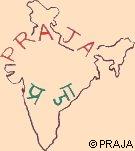Home
Why PRAJA?
Aims and Objectives
PRAJA in Action
Publications
Facts and Figures
Images & Insights
PRAJA's Team |
|
PRAJA has been trying to demonstrate that for each set of 'quantitative' statistics there is another 'qualitative' set that needs to be presented for proper understandings of the penal system:
-
There are approximately 3,50,000 persons in jail (judicial custody) in all of India, a low figure by international standards, BUT...
There is the figure of (between) 65% to 90% prisoners who are pre-trial prisoners in most jails and languish for years without being tried
- There are approximately 10,000 women prisoners in all of India (a small figure by international standards); and any average size State Jail for Women has approximately 160 prisoners at any one time BUT...
What about the fact that while a relatively progressive State like Andhra Pradesh has 775 women in prison in all its jails at any one time (June 2003 figure) it also has approximately 20,000 women (many with children) go into prison every year for varying lengths of time?
-
Almost 70 to 80 per cent of the prisoners have some form of mental/emotional/psychological problem that is the direct consequence of their imprisonment (the figure is higher for women prisoners) BUT...
Far from being a priority the concept of mental health is disregarded as a vital need by most prison practitioners and indeed the general public even when it is demonstrated that prisons damage persons
-
At least 60% of women in prison (convicts) cease to have visits from family and relatives after being in prison for over three months and some women prisoners have not seen families for five to six years as a result of their imprisonment and consequent abandonment BUT...
This seems to be a matter of little concern for those who all too readily send women into prison without thinking of the future of the families
-
Approximately 50% of women in prison are unable to resume normal (family) life after they have been through a jail experience and are at a loss in terms of what to do with their lives BUT...
There is no effort to think of their rehabilitation and the fact that a jail sentence stigmatizes a woman for life
-
Prisons exacerbate the chances and incidents of diseases (physical and mental). The commonest diseases are TB, skin ailments of many types (and specifically of sexual organs), abdominal disorders, eye and ear diseases BUT...
Not enough health and medical care is provided in prisons to alleviate this problem
-
Of every ten prisoners interviewed at least five would be unaware of their human rights outside the prison and seven of the rights inside the prison, and in the case of women this figure is often as high as eight out of ten BUT...
No efforts are made to make prisoners and particularly women aware of their rights or to tell them what is bail, remission, or parole! Many women do not know what a lawyer is!
-
In India children of imprisoned mothers are permitted to be in prison till they reach the age of six, when they may be removed and sent to extended families or 'care'. In Britain this age is 18 months. There is no debate about innocent children being in prison BUT...
The reality is that there are six year olds that come out of Indian prisons never having seen a car, a bus, a train, an aeroplane, an elephant. Little is done to remedy all this.
PRAJA has sought to start the debate about children in prison; and also initiated a scheme that children of prisoners who are in jails with mothers should be sent to schools in the community
We need to know more...
|
